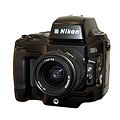Nikon E series
 | |
| Overview | |
|---|---|
| Type | Digital single lens reflex camera |
| Lens | |
| Lens | Interchangeable,Nikon F mount |
| Sensor/medium | |
| Sensor | 2/3 inchCCDVT (vacant Transfer) type with reduction optical system |
| Maximumresolution | 1.3 million pixels (1,280 X 1,000 array)[1] |
| Film speed | ISO equivalency 800, 1600 and 3200 |
| Storage media | PCMCIAImage Memory Card EC-15 |
| Focusing | |
| Focusmodes | Single-Servo Autofocus mode, Continuous-Servo Autofocus mode, Manual |
| Focusareas | TTL phase detection system using Nikon Advanced AM200 autofocus module |
| Focus bracketing | n/a |
| Exposure/metering | |
| Exposure modes | Program (P), Shutter-Priority AE (S), Aperture-Priority AE (A) and Manual (M) |
| Exposuremetering | Matrix Metering: EV 1 to 16-1/3, Center-Weighted Metering (70% centre): EV 1 to 20, Spot Metering: EV 2 to 20 |
| Flash | |
| Flash | Speedlightssupported, Standard TTL Flash possible |
| Flash bracketing | n/a |
| Shutter | |
| Shutter speedrange | 1/2 sec. to 1/2000 |
| Continuous shooting | E3: 1 frame/s E3s: 3 frame/s up to 12 images |
| Viewfinder | |
| Viewfinder | Optical type fixed eye level pentaprism Approx. 98% frame coverage, Approx. 0.7x magnification |
| Image processing | |
| White balance | Auto, Incandescent light (3,000k), Fluorescent light (6,700/5,000/4,200K), Fine weather (5,300K), Cloudy weadher (6,500K), Shade (8,000K), and Flash mode (5,700K). |
| WB bracketing | Shoot 2 to 3 frames, each at a different exposure. Compensation value range of steps from ±1/4 to ±3/4. Select among 9 combinations. |
| General | |
| LCD screen | None |
| Battery | Ni-MH Battery Pack EN-3 |
| Weight | approx. 1,850g |
| Made in | |
TheNikon E series,co-developed withFujifilm,[2]areautofocus1.3megapixelprofessional grade quasi-full frame(35mm)Nikon F-mountdigital single lens reflex cameras (DSLR) manufactured byNikonsince 1995.
The E series included theNikon E2/E2S,Nikon E2N/E2NSand theNikon E3/E3S.The S-variants are identical except they had triple the frame rate and a larger buffer.
Itsunique optical systembundles the light of the full-frame lenses to the small2/3 inchCCDsensor. That gives approximately 4stopsmore light at the small sensor, therefore delivering an exceptional (for that time) minimum sensitivity of 800 and maximum 3200ISO,which remains usable for press and news use.[2]
Technology
[edit]
The Nikon E2/E2S and E2N/E2NS use aNikon F4subsystem, the E3/E3S uses aNikon F100subsystem.[3]
Optical system
[edit]The E series uses a unique additional optical system that enables the small sensor to capture the field of view of a 35mm film, with acrop factorof 1. This comes not at the expense of theF-stopof the lenses, because the light is bundled to the2⁄3inch CCD sensor with approximately 16 times smaller area. The result is approximately4 stops (24= 16) more lightat the small sensor compared to a full-frame sensor. Therefore, the camera has a minimum full-frame sensitivity ofISO800 which is equivalent to ISO 50 at2⁄3inch. As a result, the noise of the camera at ISO 800 full-frame is equivalent to ISO 50 of the2⁄3inch CCD sensor. Nikon could not reduce sensitivity below 800 ISO full-frame, because the little sensor will be overexposed below 50 ISO.
The exceptional high sensitivity up to 3200 ISO (equivalent 200 ISO,2⁄3inch) can be seen as an advantage for indoor oravailable lightphotography and is important for professional press and sports use, the customer target area.
Although the camera is small for a 90s DSLR, the additional optical system makes the camera deeper compared to today's DSLRs.
StandardNikon F-mountlenses can be used.
Storage and replay
[edit]APCMCIAcompatible memory card is used. Images are digitally stored as uncompressed TIFF or compressed JPEG. It can be accessed via aSCSIconnector.TV replay (NTSC or PAL) is possible.[4]
Variants
[edit]History
[edit]Nikon gained knowledge on digital cameras (still video cameras,with analog storage) by constructing theNikon Still Video Camera(SVC) Model 1, a prototype which was first presented atphotokina 1986.[5][6]The followerNikon QV-1000CStill Video Camera was produced since 1988 mainly for professional press use.[7]Both cameras used QV mount lenses, a variant ofF-mountlenses. Via an adapter (QM-100) other Nikkor lenses can be fitted.
TheNikon NASA F4was one of the first cameras with digital storage.Eastman Kodakused Nikon SLR's to design theKodak DCS 100and followers.
Nikon E2/E2S
[edit]This first variant was manufactured since 1995 and were also available asFujifilmFujix DS-505 and DS-515.
Nikon E2N/E2NS
[edit]Announced 1996. Also available asFujifilmFujix DS-505A and DS-515A.
Nikon E3/E3S
[edit]TheNikon E3andNikon E3S,co-developed withFujifilmand marketed also as theFujix DS-560andFujix DS-565,[2]areautofocus1.3megapixelprofessional grade quasi-full frame(35mm)digital single lens reflex cameras(DSLR) announced by theNikon Corporationon 15 June 1998[8]and released in December 1999. The E3S is identical to the E3 except triple frame rate and larger buffer. They are followers of theNikon E2N/E2NS.
See also
[edit]References
[edit]- ^Nikon E3/E3s Digital Still SLR Camera - SpecificationsMIR
- ^abcFujix DS-565 (aka Nikon E3S)
- ^McBroom's Camera Bluebook By Michael McBroom
- ^Nikon E3/E3s Digital Still SLR CameraMIR
- ^Additional information on Nikon Video Still Camera Model 1 & Nikon QV-1000C Still Video CameraMIR
- ^Nikon Still Video Camera (prototype)Nikonweb
- ^Nikon QV-1000C? Never heard of it.Nikonweb
- ^Professional digital cameras Nikon E3 / E3s Digital Camera Refinement RedefinedNikon



